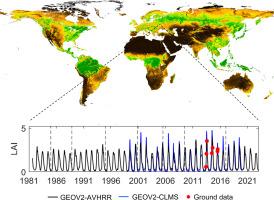GEOV2-AVHRR: 1981 - 2022年全球叶面积指数和PAR吸收分数的连续一致时间序列
IF 11.4
1区 地球科学
Q1 ENVIRONMENTAL SCIENCES
引用次数: 0
摘要
全球变化研究需要全球叶面积指数(LAI)和光合有效辐射吸收分数(FAPAR)的长期时间序列来表征植被动态。最近开发的哥白尼土地监测服务GEOV2-CLMS产品在完整性、时间平滑性、变量间一致性和准确性方面优于其他现有的LAI和FAPAR产品。然而,这些GEOV2-CLMS产品来源于SPOT/VGT和PROBA-V星座,时间覆盖范围为1999年至2020年,这限制了其在全球变化研究中的适用性。本文将GEOV2-CLMS算法应用于AVHRR,对这些时间序列进行扩展,生成1981年7月至2022年12月的长期全球植被产品。GEOV2-AVHRR算法旨在最大限度地提高NOAA和MetOp-B卫星上连续AVHRR传感器的时间一致性,同时保持与GEOV2-CLMS产品的高度一致性。神经网络首先将AVHRR地表反射率转化为日时间步长的LAI和FAPAR值。然后每10天对每日估计进行过滤、平滑、填补空白和合成。GEOV2-AVHRR在DIRECT2.1和GBOV V3数据集的树木和非树木位点上的精度误差在- 0.2和0.3 LAI和~ - 0.03 FAPAR之间,不确定性为<;1 LAI和~ 0.10-0.15。GEOV2-AVHRR与GEOV2-CLMS (MODIS)的不确定度一致:92%(76%)的土地像元在±max(20%, 0.5) LAI范围内,71%(34%)的土地像元在±max(10%, 0.05) FAPAR不确定度要求范围内。与MODIS相比,GEOV2-AVHRR中应用的间隙填充和时间滤波器有效地提高了LAI和FAPAR时间序列的完整性(仅缺失数据的1%)和时间精度(平滑度)。GEOV2-AVHRR的年内一致性与GEOV2-CLMS高度一致,说明其主要受算法驱动。相反,LAI和FAPAR数据集的年际一致性似乎对输入地表反射率的一致性非常敏感。经MODIS LAI/FAPAR评价,GEOV2-AVHRR具有较高的稳定性,提高了GEOV2-CLMS的稳定性。对于GEOV2-AVHRR以及其他长期AVHRR数据集(即GIMMS, GLASS和C3S),观察到从过渡到传感器的一些剩余年际不一致。GEOV2-AVHRR显示了约70%的土地像元的总体绿化趋势(在p <; 0.05显著性为约50%),趋势的幅度和空间格局与GIMMS的结果高度一致。本文章由计算机程序翻译,如有差异,请以英文原文为准。

GEOV2-AVHRR: Continuous and consistent time series of global leaf area index and fraction absorbed PAR from 1981 to 2022
Long-term time series of global leaf area index (LAI) and fraction of absorbed photosynthetic active radiation (FAPAR) are required for characterizing vegetation dynamics in global change studies. The recently developed Copernicus Land Monitoring Service GEOV2-CLMS products were demonstrated to outperform other existing LAI and FAPAR products in terms of completeness, temporal smoothness, consistency across variables and accuracy. However, these GEOV2-CLMS products are derived from the SPOT/VGT and PROBA-V constellation with temporal coverage from 1999 to 2020 which limits its applicability for global change studies. We present here an adaptation of the GEOV2-CLMS algorithm to AVHRR to extend these time series and generate long-term global vegetation products from July 1981 to December 2022. The GEOV2-AVHRR algorithm was specifically designed to maximize the temporal consistency over the successive AVHRR sensors on board NOAA and MetOp-B satellites while keeping high agreement with GEOV2-CLMS products. Neural networks first transform AVHRR surface reflectance into LAI and FAPAR values at the daily time step. The daily estimates are then filtered, smoothed, gap filled and composited every 10-day.
GEOV2-AVHRR showed accuracy error between −0.2 and 0.3 LAI and ∼ −0.03 FAPAR and uncertainty <1 LAI and ∼ 0.10–0.15 for woody and non-woody sites of both DIRECT2.1 and GBOV V3 datasets. GEOV2-AVHRR agreed well with GEOV2-CLMS (MODIS): 92 % (76 %) of land pixels are within ±max(20 %, 0.5) LAI and 71 % (34 %) within ±max(10 %, 0.05) FAPAR uncertainty requirements. The gap filling and temporal filters applied in GEOV2-AVHRR proved effective in improving the completeness (only 1 % of missing data) and temporal precision (smoothness) of LAI and FAPAR time series as compared to MODIS. The intra-annual consistency of GEOV2-AVHRR highly agree with GEOV2-CLMS, indicating it is mostly driven by the algorithm. On the contrary, the inter-annual consistency of LAI and FAPAR datasets appears to be very sensitive to the consistency of the input surface reflectance. GEOV2-AVHRR showed high stability as evaluated with MODIS LAI/FAPAR and improves the stability of GEOV2-CLMS. Some residual inter-annual inconsistencies from the transition to sensors are observed for GEOV2-AVHRR as well as for other long term AVHRR datasets (i.e. GIMMS, GLASS and C3S). GEOV2-AVHRR shows overall greening trends in ∼70 % (∼50 % significant at p < 0.05) of land pixels, and the magnitude and spatial pattern of trends highly agree with those of GIMMS.
求助全文
通过发布文献求助,成功后即可免费获取论文全文。
去求助
来源期刊

Remote Sensing of Environment
环境科学-成像科学与照相技术
CiteScore
25.10
自引率
8.90%
发文量
455
审稿时长
53 days
期刊介绍:
Remote Sensing of Environment (RSE) serves the Earth observation community by disseminating results on the theory, science, applications, and technology that contribute to advancing the field of remote sensing. With a thoroughly interdisciplinary approach, RSE encompasses terrestrial, oceanic, and atmospheric sensing.
The journal emphasizes biophysical and quantitative approaches to remote sensing at local to global scales, covering a diverse range of applications and techniques.
RSE serves as a vital platform for the exchange of knowledge and advancements in the dynamic field of remote sensing.
 求助内容:
求助内容: 应助结果提醒方式:
应助结果提醒方式:


